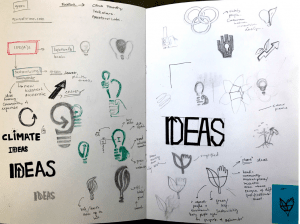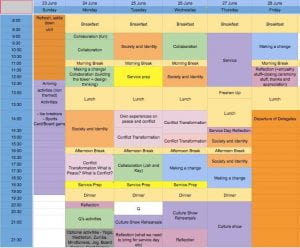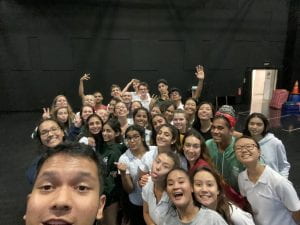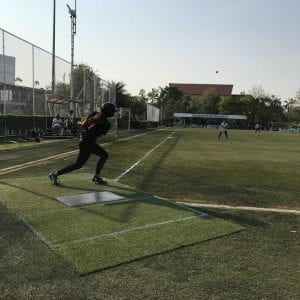As I gathered an abundance of literary journals and academic papers, I found it overwhelming and time consuming to filter out and pick information I would specifically use in my writing. I used textbooks, journals and online academic papers to source research done by professors and authors. The expert opinions and perspectives I applied, strengthened the claims I made in my writing. As disability studies deeply interested me, I often caught myself writing off tangent and straying away from the focus of my paper, thus my supervisor advised me to minimise this habit by prioritising information and referring back to my plan of the structure of my essay. My supervisor thinks I must embed more research and context in my first few paragraphs where it has been overpowered by analysis. This is to ensure the purpose of my essay is clear and understood from the beginning.
Author: hoet15754@gapps.uwcsea.edu.sg
Conceptual Understanding on Perception
Selective Attention my alters different people’s truths, though they’re observing the same experience.
Selective attention is the cognitive process of focusing on a particular object in the environment for a certain period of time, whilst ignoring the other inputs that our brain deems unimportant in the same immediate environment. Attention is a limited resource and our as humans we biologically cannot process all the information around us at all the time, so selective attention allows us to tune out unimportant details and focus on what matters. This influences our ability to perceive the world accurately as it means we will often miss out on information that we may specifically be looking out for. But once we are told what to look for and expect, we subconsciously erase all that does not fit. This theory can be seen when we did the famous Harvard study, where we were instructed to count the number of balls thrown by a certain group – white or black. As we are so focused on counting the number of passes, many participants simply miss the gorilla that enters the scene, or the fact that the curtains change colour. This pushes us to question how if our truths that we construct through our senses are fully accurate, did we miss something part of the bigger picture? When people devote their attention to a particular object or factor, the unexpected tends to go unnoticed even when those unexpected objects are potentially important, most noticeable or right in front of them. Because subconsciously we all individually choose what we believes is important to remember, it sometimes leads us to garnering different variations of reality where some people ‘saw more’ than others.
The human brain’s need of sense-making subconsciously organises our observations to optimize our survival, hence making certainty challenging to attain.
The human brain has evolved to become particularly skilled at sense-making: creating patterns out of our observations, finding human faces from inanimate objects, allocating persona’s to moving dots based on their speed and distance from each other. These few examples highlight the shortcut that our subconscious mind often takes, its ability to sense make allows us to learn and absorb information easier, though possibly warping the truth in the process. When Mr.Alchin showed the dots moving on screen, our perception of the persona created from these dots changed alongside the speed and distance the dots vibrated – the audience recognised both a female walking and a male walking simply through the alteration of the dots movement. But nonetheless, though our brain perceived the dots as walking figgures, the truth stands that they were merely dots, but our pre-existing notions of what male and female’s walk like, allowed us to extrapolate a false truth. This leads us to question, what particular types of knowledge, or areas of knowledge are most affected by the potential flaws presented in perception. Areas of Knowledge such as science and history, where knowledge is (either heavily or partially) created through people’s perception of events. It can argue that as they are greatly based on perception they can only operate within the idea of Plato’s cave, where our senses only provide us with an obscured reality, a reality constructed in our own brains, shadows on the cave wall. Only when reason to operate on the perceptions, we can get glimpses of the noumenal. When looking through this lens, then we can also assume that Maths is one of the areas of knowledge that operates within a noumenal space. This is because the methods of obtaining knowledge does not rely on perception and senses, but instead blossom off of pre-existing axioms.
Intra Internship: Reflection 2
End of Week 1:
Here I talk about my first Project: The process of designing the logo.
I was briefed on my 2nd project: Designing a compact (100m2) “group training” gym interior for a client, James Zhao/MANA Training Gym (James is an Australian presently Beijing-based). This gym will be a working prototype and our design will be refined as we work towards James’s goal to have 6 of these in selected locations in Beijing.
Starting to design the floorplan for the tight fitted crossfit gym, I took the existing scale model from the old site, cut up the equipment and began arranging it on paper as a beginning exercise. I had to consider reach, range of motion for those exercising, obstruction and clear walkways, and maximising the small space. #LO1 #LO2 I started manually on the plan and doing sketches as that’s where my expertise lay, after I was happy with my setup on paper, I took it to AutoCad (an architecture software that I was unfamiliar with) and began creating the model on the computer. This was particularly challenging as I had to develop a primary level proficiency in the software very quickly to create a ‘up-to standard’ model. Although I don’t perceive myself to be very talented on the computer, I believe being able to use CAD Software is a very valuable skill that is regarded in the growing industry or architecture.
Lastly I challenged myself to create a CAD model of a residential house using Sketchup – an application I was not familiar with but would be useful and quite necessary in my future profession.
Pre Internship: Reflection 1
Preparing for this Internship, I had to curate a portfolio made up of my artworks and designs. These works were either done in my Fine Arts or Design Technology Class or work I created in my free time.
My main goal is to better understand the working life of an architect. The field of architecture is constantly evolving, and is currently predominantly molded by the advancements of design technology: a model that would once take days to perfectly sketch up now can be done in under hours using Computer Aided Design (CAD), laser cutting and other advanced software. Therefore the working space and lifestyle of an architect is also said to be more fluid then most jobs.
The company I will be interning at is based in Sydney Australia, and is a small architectural firm curating projects on residential housing, larger residential complexes and communal buildings. Moreover they also do commision of graphic design, interior design etc. hence this experience will give me a taste of working in multiple fields of design. I’m hoping this experience will help me gain a more concrete understanding of what field I wish to pursue (albeit Architecture, Urban Landscaping or Industrial Design.)
My first assigned project: The client + its business: Innovation Driven Enterprises in Asia for Sustainability: IDE(A)S – an incubator to help people develop their inventions into viable propositions to bring to market. Point of differentiation from other government, semi/quasi-public and private sector entities will be its particular focus on people and companies which have a quantifiable and largely technology driven/enabled and environmentally sustainable angle. In essence, a technical/technological proposition which has both invention and innovation to propel it. The client will approach government for support as it also looks to raise seed funding privately. The client aims to bring together the inventors/creators, financial investors/backers and manufacturers and provide the necessary expertise in management and administration to manifest ideas into profitable realities. IDE(A)S will only exist with government support in some financial form and it will be headquartered in Singapore. Its business reach is intended to be regional if not global. Supersoma will also be invited to tender for the design of its first office/workshop/laboratory which will be situated in Singapore.
My 1st Challenge: Create a logo for IDE(A)S
ACTIVITY: IFP – FINAL REFLECTION
Highlight of the trip: Last session I planned of conflict transformation – intense impact
What I learnt about being a good facilitator:
- The importance of guiding, not teaching: I had to focus on speaking less and allowing delegates to independently learn and make the connections on their own time.
- The greatest understanding of peacebuilding is developed through the delegates internal linking and absorption of the strategies and topics we discussed.
- The level of involvement and enthusiasm of both the facilitators and delegates fluctuates, which is perfectly normal.
- The determinant of the success of the conference is the change and progress delegates make in their own communities in the time following the conference. The effects of peacebuilding are often not immediately seen.
One thing i learnt about running a conference :
- You have to be very flexible. The service day planning particularly struck me as an important learning curve since we were faced with the challenge of organizing the plans for the day on the spot. Although it was chaotic at first, it taught me how greatly I value the having a team that is quick thinking and hands on.
- Speaking and giving instructions – pace and voice, power of pausing.
- Use examples and templates – people need guidance (having visuals for people to look at will help them anchor what you’re saying to something tangible)
- In the case of IFP, a very valuable (but often overlooked) piece of advice I would give is to treat them like they’re people and not a service project. Listen with intent, and respond with care, just as you would in any other friendship.
Big takeaways +- from each day
Monday/Tuesday – In the sessions over monday and tuesday we handled subjects of identity and stereotypes and began introducing ideas of design thinking. A few times during the first few days I would question if the activities we ran were relevant or even necessary since we spent so much time doing fun interactive activities that aimed to help one learn more about themselves, the stereotypes they hold and their identity: what they value most, who they really are. Then I realised that although I have done so much self evaluation and reflection over my years in school, many of these individuals attending the conference hadn’t. A lot of them were not ever given this voice or opportunity to explore themselves and deeply reflect. So although the first few days went a bit slow, it was necessary in building the general comfort level of the group, and allowing individuals to get into the mindset of evaluating what makes them them. It set up a great foundation for the very vulnerable and emotional sessions that preceded.
Wednesday – #LO6 The trauma of the conflicts and violence these people have experienced and still experience doesn’t end when this conference ends. Moe Tee still has to return to an unstable family setting, and Tint Tint still cannot go home in fear of the civil violence. The last session my group ran was an emotional session that for many of them provided a sense of catharsis. Each individual wrote anonymously on two cards: a moment of pure peace and happiness and an experience with conflict/violence. The cards were then placed randomly around the room, and we sat and read the cards for 45 mins. This activity was so emotional as it provided them with a window of pure vulnerability if they chose to. Many cards were deeply impactful and after the session, the tears and the shock brought people closer together, and made people feel empowered and supported. I was very proud of myself and my group for running such a session. It took awhile for me to realise that although the session went well and I felt like celebrating, the issues that many of them had spoken or written about were still impacting their lives, and might continue the moment they leave the conference. The fact that many delegates had skipped days of school and saved up money to make it to the conference, evoked a sense of guilt within me the moment I remembered I was off to a relaxing summer abroad the moment the conference ended.
When I was attending IFP as an afterschool activity, I hadn’t yet grasped the magnitude of impact it would have on me or others; it was simply an afterschool activity. I’m grateful to the movement and people that encompass what IFP, for pushing me to develop a passion for peacebuilding.
Thursday – #LO5 Being on the service team and having to coordinate the service morning was both extremely stressful yet rewarding. It proved itself a big obstacle as it was hard to prepare the service morning in our sessions at school because of the limited amount of information we could access. Because the delegates would have to plan their own service session and what they wanted to do, we couldn’t inform Kritsana (our contact at the hotel) and our partnered school what kind of activities they were going to do. When it came time to explain the service morning to the delegates it was very unclear and left most people confused and quite worried as for many of them, it was their first time planning their own volunteer/service session. After the horrid explanation session, the service team sat for an hour and a half and worked through our prominent issues.The next day we visited the school and cleared up many questions such as what the space looks like, how many children each group would work with etc. Another surprise was that we were also forced to change the day the service session ran (wednesday to thursday). Working in the service team showed me how flexible one must be when organising and planning events or conferences. On the day itself, though I did a lot of running around and making sure everything was running smoothly, it was the thorough preparation and planning that the team did last minute that made it a successful morning. The importance of planning but also anticipating change and adapting to it was an incredibly vital lesson I learnt through planning the service morning.
#LO7 making a change last session – delegates were incredibly ambitious, but more than that were logical and structured plans on how to change their communities. Whether it was creating weekend workshops to educate the youth on drug use, running days for tree planting programmes or creating educational apps for iphone and androids – each of these delegates had a logical and structured plan on how to begin. It was incredible seeing the template and knowledge that the “Making a Change” Group had presented, been applied to each of their plans. It wasn’t just a dream anymore, but was becoming a tangible plan, and that was the most important thing to see. The service hours and the sessions we ran ultimately had no meaning of these individuals didn’t take anything away from it. It’s great everyone made new friends, but the conference wouldn’t have been successful if no change was made after it ended. The real results of success arise not now, but later: when we see the impact these delegates had on their community. Peacebuilding is never instantaneously effective, often the impacts only reveal after a while, and only then can we determine the success of conference we facilitators created.
Friday – Goodbye ceremony. Farewell session. 🙁
‘
First Reflection, Behind the Beautiful Forevers – A Theatre Production
Audition Process : The thought of auditioning made me extremely nervous, and reminded me of last years auditions when I wasn’t able to make the cut. I decided to audition very last minute even though I was still unsure and uncertain of my abilities. Underneath the general nervousness, I felt quite felt generally insecure of my acting capabilities in comparison to the rest of those that were auditioning. At the end of last year, I was also very busy and overwhelmed with all the work and external tasks I had to handle. Nonetheless I did audition, and ultimately, I am so glad I did.
The first few weeks of the production process consisted of very hectic and creative brainstorming sessions. We immersed ourselves into the books context, researching daily life in the “annawadi” slums, the culture and the beliefs that brought the communities there to life. Along with constructing the facades of our own set, we also focused on little details (kids playing cricket, ladies fetching water) to create add depth and reality into our performance.
Service End of Year Reflection
Here is the link to our in-depth SWOT analysis.
This years service experience has been extremely fulfilling and I am grateful to this experience for broadening my understanding of what it truly means to give back to my community.
Project week Reflection
#LO1 Identify your own strengths and develop areas for personal growth.
Naturally I find myself to often take on a leadership position, therefore during our planning process I took upon the general management role, and did the first aid course. The first aid course was arduous but I found it incredibly useful and made me a more aware traveller and group leader. I found that I become more of a mother figure during the trip, and found that my tendencies to try and control my surroundings are very strong when I travel.
brainstorming initial ideas doc
This history and culture tour of Intramuros was my highlight of the trip. Initially I had low expectations but I was immediately blown away with how much historical significance and value this small section of manila had. It was an incredibly fun yet eye opening tour as our guide (Manny) highlighted both the gruesome stories that emerged in this area, but also stories of empowerment and strength.
Our Aerial Yoga Session was a new experience for all of us and was physically demanding, especially after a long car ride the day before.
Activity: IFP – Planning Process
Beginning
123
I am a Project Manager. Connecting with Participants – all like minded, hard working individuals (5)
Facilitator
(4) Weekend sessions – 8:30-4:30, Afterschool long sesh 4:30-8
(6) Lots of consequences and areas to go wrong. Cultures with existing conflict coming together. Potential turmoil to arise, we must educate, mediate and support those attending the conference. Many diff. ethnic groups. Responsibility of producing a high quality conference, lots of pressure. A very new experience in managing and Facilitating.
Middle
End
Conflict Transformation Sessions :
Planning and Research document
Service Sessions:
Activity: Softball (Pre-Season and Season)
#LO4 #LO2 Softball was extremely challenging this year as I had to take on a new position: pitching. It required me to learn foreign skills from scratch in a very short amount of time. Although it was initially mundane, I knew the repetition was key in building a good pitching foundation. During pre-season I had felt that although I was putting in a lot of time and effort, I was seeing little improvements in game results. Of course this was extremely frustrating, but through perseverance and confidence in my play, I could see clear improvements by the end of the season.
Throughout the season I have grown increasingly comfortable with the girls on the team, and often relied on my team members to cheer me up when I was feeling particularly down about how I was playing. Spirit and cheer is such a key component to many team sports – including softball – and over the years I have recognized that apart from performing well, putting in the effort to lift the spirit of the team is a responsibility of any team member. Lastly, this season also taught me that winning doesn’t always mean we are entitled to celebrate: we must win with grace.
I’m very excited for my last and fourth year of softball next year!











